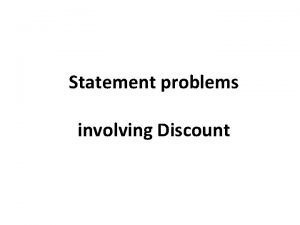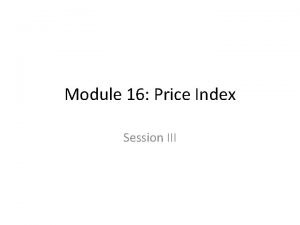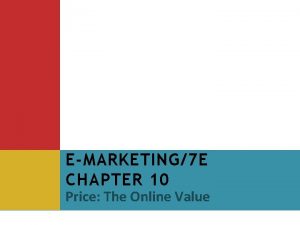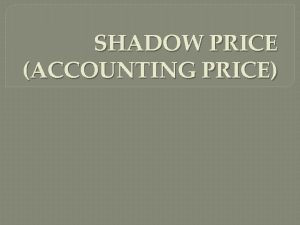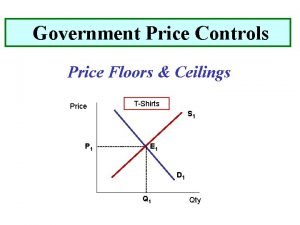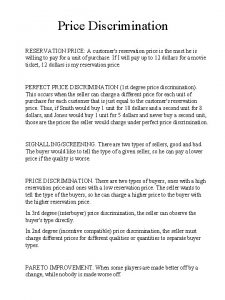EMARKETING7 E CHAPTER 10 Price The Online Value







































- Slides: 39

E-MARKETING/7 E CHAPTER 10 Price: The Online Value

10 -2 CHAPTER 10 OBJECTIVES After reading Chapter 10, you will be able to: Identify the main fixed and dynamic pricing strategies used for selling online. Discuss the buyer’s view of pricing online in relation to real costs and buyer control. Highlight the seller’s view of pricing online in relation to internal and external factors. Outline the arguments for and against the internet as an efficient market. Describe several types of online payment systems and their benefits to online retailers. © 2014 PEARSON EDUCATION, INC. PUBLISHING AS PRENTICE HALL

THE PRICE OF AN IPHONE APP 10 -3 Mobile apps have different pricing and revenue models. In June 2011, 52% of top game app revenue came from freemium games. Freemium is when companies offer a basic product for free and an upgraded version for a fee. Lite versions are sold at low prices with fewer features. Full price versions include more features. So how can companies monetize apps? When the freemium version of the Instapaper app was removed, sales of the paid app increased. The company also noticed that few people upgraded from freemium to the paid version. © 2014 PEARSON EDUCATION, INC. PUBLISHING AS PRENTICE HALL

THE INTERNET CHANGES PRICING STRATEGIES 10 -4 Identify the main fixed and dynamic pricing strategies used for selling online. Price is the sum of all values (such as money, time, energy and psychic) that buyers exchange for the benefits of a good or service. Throughout history, prices were negotiated; fixed price policies are a modern idea. The Internet is taking us back to an era of dynamic pricing--varying prices for individual customers. The Internet also allows for price transparency --both buyers and sellers can view prices online. © 2014 PEARSON EDUCATION, INC. PUBLISHING AS PRENTICE HALL

BUYER & SELLER PERSPECTIVES 10 -5 The meaning of price depends on viewpoints of the buyer and the seller. Each party to the exchange brings different needs and objectives that help describe a fair price. In the end, both parties must agree or no sale take place. Buyer view Seller view © 2014 PEARSON EDUCATION, INC. PUBLISHING AS PRENTICE HALL

BUYER & SELLER PERSPECTIVES BUYER VIEW 10 -6 Discuss the buyer’s view of pricing online in relation to real costs and buyer control. Buyer’s costs may include money, time, energy, and psychic costs. Buyers defined Value = Benefits – Costs Real Costs 2. Buyer Control 1. © 2014 PEARSON EDUCATION, INC. PUBLISHING AS PRENTICE HALL

BUYER VIEW REAL COSTS 10 -7 The seller’s price may or may not include shipping, tax, and other hidden elements. Hidden elements: costs that often are not revealed online until the last screen of shopping experience. Buying on the Internet can both increase and decrease overall costs. The Internet technologies and content are far from perfect, but as broadband adoption continue to increase, technology evolves, and firms develop better online strategies, some costs will decline. © 2014 PEARSON EDUCATION, INC. PUBLISHING AS PRENTICE HALL

BUYER VIEW REAL COSTS, CONT. 10 -8 Buyers may enjoy online cost savings which come from: The Internet is convenient: it is open 24 x 7 x 365 (for search, shop, entertainment…) The Internet is fast: download times may not be acceptable to some, but product delivery can sometimes be next day. Self-service saves time: track shipments, pay bills, trade securities, check account balances, request product information and receive it immediately…etc. with no need of human interaction. © 2014 PEARSON EDUCATION, INC. PUBLISHING AS PRENTICE HALL

BUYER VIEW REAL COSTS, CONT. 10 -9 One-stop shopping: comprehensive selection of goods or services at a single location. The Internet offer virtually unlimited goods and services. Integration save time: Web portals like Yahoo and Google Mobile allow for ease of use and customization. Automation saves energy: Simplicity and ease creates happy consumer. Finally, not everyone wants to save money in online transactions. Customer needs and their value proposition vary as each individual weighs the desired and perceived benefits against all the costs, e. g. Amazon © 2014 PEARSON EDUCATION, INC. PUBLISHING AS PRENTICE HALL

BUYER VIEW, CONT. BUYER CONTROL 10 -10 The shift in power from seller to buyer affects pricing strategies. Buyers set prices and sellers decide whether to accept the prices in a reverse auction. In the B 2 B market, buyers bid for excess inventory at exchanges. In the B 2 G market, government buyers request proposals for materials and labor. Online sellers are more willing to negotiate. Online buyers have access to huge amounts of information © 2014 PEARSON EDUCATION, INC. PUBLISHING AS PRENTICE HALL

10 -11 Highlight the seller’s view of pricing online in relation to internal and external factors. BUYER & SELLER PERSPECTIVES SELLER VIEW Sellers view price as the amount of money they receive from buyers, unless they are making a barter exchange. All sellers want/need to make a profit. Between cost and price is profit. The seller’s perspective includes Internal Factors & 2. External Factors 1. © 2014 PEARSON EDUCATION, INC. PUBLISHING AS PRENTICE HALL

SELLER VIEW: INTERNAL FACTORS, CONT. PRICING OBJECTIVES 10 -12 Internal factors include a. Pricing objectives may be: Profit-oriented objective Pricing is set for current profit maximization Focus’s on short term success Market-oriented objective Goal is to build a larger customer base May lead to lower prices and higher long-run profits Negotiation & bidding are Market-oriented approaches Competition-based pricing Pricing according to what competitors are charging, thus pay less attention to the firm’s own costs or to demand. © 2014 PEARSON EDUCATION, INC. PUBLISHING AS PRENTICE HALL

SELLER VIEW: INTERNAL FACTORS, CONT. MARKETING MIX STRATEGY & IT 10 -13 b. Marketing mix strategy Successful companies use an integrated and consistent marketing mix strategy The Internet is only one sales channel Internet should be used in concert with other marketing mix elements c. Information technology Information technologies can be expensive, but should ultimately create tremendous cost efficiencies The Internet Puts Upward Pressure on Prices The Internet Puts Downward Pressure on Prices © 2014 PEARSON EDUCATION, INC. PUBLISHING AS PRENTICE HALL

I NTERNAL FACTORS , C ONT. I NFORMATION TECHNOLOGY 10 -14 T HE I NTERNET P UTS U PWARD P RESSUREON P RICES Some of the factors that put Upward Pressure on Internet pricing : Online customer service is an expensive competitive necessity. Distribution and shipping costs. Affiliate programs add commission costs. Site development and maintenance. Social media maintenance Customer acquisition costs (CAC) The cost of acquiring new customers online is quite high. The average CAC for early online retailing was $82. © 2014 PEARSON EDUCATION, INC. PUBLISHING AS PRENTICE HALL

I NTERNALFACTORS , C ONT. I NFORMATION TECHNOLOGY 10 -15 T HE I NTERNET P UTS D OWNWARD P RESSUREON P RICES Downward Pressure on Prices: Firms can save money by using Internet technology for internal processes. Some cost saving ways include: Order processing - self-service. Just-in-time inventory. Overhead (e. g. Amazon’s physical warehouses). Customer service. Printing and mailing. Digital product distribution costs. These efficiencies usually result in lower prices for customers online. © 2014 PEARSON EDUCATION, INC. PUBLISHING AS PRENTICE HALL

SELLER VIEW: EXTERNAL FACTORS MARKET STRUCTURE AND COMPETITION 10 -16 External factors affecting online pricing include Market structure and Market Efficiency 1. Market structure and competition: The seller’s margin to set prices varies by market type: Pure competition: Many buyers and sellers trading in a uniform commodity (e. g. corn). Monopolistic competition: Many buyers and sellers trading over a range of prices. Sellers can differentiate their offers to buyers (Online courses). © 2014 PEARSON EDUCATION, INC. PUBLISHING AS PRENTICE HALL

SELLER VIEW: EXTERNAL FACTORS MARKET STRUCTURE AND COMPETITION 10 -17 Oligopolistic competition: Few sellers sensitive to each other’s pricing & marketing strategies. If a company drops its prices by 5%, buyers will switch quickly to this supplier (e. g. Online travel agents). Pure monopoly: One seller whose prices are usually regulated by government (e. g. ISP). q If price transparency results in a completely efficient market, sellers will have no control over online prices. © 2014 PEARSON EDUCATION, INC. PUBLISHING AS PRENTICE HALL

SELLER VIEW: EXTERNAL FACTORS, CONT. MARKET EFFICIENCY 10 -18 2. Market Efficiency: A market is efficient when customers have equal access to information about products, prices, and distribution (e. g. stock market). In an efficient market, one would expect to find: Lower prices, High price elasticity, Frequent price changes, Smaller price changes and Narrow price dispersion. The Internet is an ideal test ground for efficient markets because it exhibits many of the approriate characteristics of an efficient market. © 2014 PEARSON EDUCATION, INC. PUBLISHING AS PRENTICE HALL

10 -19 EFFICIENT MARKETS MEAN LOSS OF PRICING CONTROL © 2014 PEARSON EDUCATION, INC. PUBLISHING AS PRENTICE HALL

IS THE INTERNET AN EFFICIENT MARKET? 10 -20 Outline the arguments for and against the Net as an efficient market. The following eternal market factors place a downward pressure on Internet prices and contributing to efficiency: Shopping agents such as Biz. Rate. Flash sales (limited-time offers for site members). High price elasticity. Reverse auctions. Tax-free zones. Venture capital. Competition. Frequent price changes. Smaller price change increments. © 2014 PEARSON EDUCATION, INC. PUBLISHING AS PRENTICE HALL

IS THE NET AN INEFFICIENT MARKET? CONT. 10 -21 The Internet does not act like an efficient market with respect to narrow price dispersion. Price dispersion may relate to various reasons: Branding and brand strength. Differentiation. Online pricing. Delivery options. Time-sensitive shoppers. Switching costs. Second-generation shopping agents. © 2014 PEARSON EDUCATION, INC. PUBLISHING AS PRENTICE HALL

IS THE INTERNET AN EFFICIENT / INEFFICIENT MARKET? CONT. 10 -22 Is the Internet an efficient Market? The Internet is not an efficient market, not now. However it has all the features to move toward efficiency in the future. © 2014 PEARSON EDUCATION, INC. PUBLISHING AS PRENTICE HALL

PAYMENT OPTIONS 10 -23 Electronic money, also called e-money or Describe digital cash, is a system that uses the Internet several types of online and computers to exchange payments payment electronically. systems and Off-line e-money payment systems include: their benefits Smart chips (e. g. watches, cell phones). to online Mobile wallets (e. g. Google application). retailers. For one-time payments, Pay. Pal has become the industry standard with over 113 million accounts worldwide. © 2014 PEARSON EDUCATION, INC. PUBLISHING AS PRENTICE HALL

PRICING STRATEGIES 10 -24 Price setting is full of contradictions and has become an art as much as a science. How marketers apply pricing strategy is as important as how much they charge. If prices are too high, sales may decline, if prices are too low profits will suffer. Pricing is the easiest part of the marketing mix, but because it has the biggest impact on the bottom line, it can be the most difficult decision for marketers to make. Buyer value perceptions vary between rational and emotional, and consumers react differently. © 2014 PEARSON EDUCATION, INC. PUBLISHING AS PRENTICE HALL

PRICING STRATEGIES, CONT. 10 -25 Marketers can employ all traditional pricing strategies to the online environment. Fixed pricing, Dynamic pricing, Renting Software, Price Placement on Web Pages. © 2014 PEARSON EDUCATION, INC. PUBLISHING AS PRENTICE HALL

PRICING STRATEGIES, CONT. FIXED PRICING 10 -26 Fixed pricing (also called menu pricing) occurs when sellers set the price and buyers must take it or leave it. Commonly used by many brick-andmortar firms. Everyone pays the same price. Three common fixed pricing strategies are: Price leadership. Promotional pricing. Freemium pricing © 2014 PEARSON EDUCATION, INC. PUBLISHING AS PRENTICE HALL

PRICING STRATEGIES FIXED PRICING, CONT. 10 -27 Price leadership (Buy. com) Promotional pricing (Amazon) Lowest priced product in a particular category Both online and offline, Walmart is a price leader Most often, the largest producer becomes the price leader due to economies of scale Encourages a first purchase Encourages repeat business Assists in closing a sale Freemium pricing (Skype) Free versions of products Upgrades available for a fee © 2014 PEARSON EDUCATION, INC. PUBLISHING AS PRENTICE HALL

PRICING STRATEGIES DYNAMIC PRICING 10 -28 Dynamic pricing is the strategy of offering different prices to different customers. Airlines have long used dynamic pricing when pricing air travel. Unlike fixed pricing, dynamic pricing can be initiated by the seller or buyer. There are two types of dynamic pricing: Segmented pricing. a. Geographic Segment Pricing b. Value Segment Pricing Price negotiation. © 2014 PEARSON EDUCATION, INC. PUBLISHING AS PRENTICE HALL

PRICING STRATEGIES: DYNAMIC PRICING, CONT. 10 -29 Segmented Pricing levels are set based on order size and timing, demand supply levels, or other factors. Thus the firm set pricing levels for segments of customers and uses decision-making software to determine who gets what price. Firms use decision rules to determine who pays what price. Segments may be many or one Firm’s use cookie files to experiment with customer specific offers and prices to motivate transactions Segmented pricing is becoming more common as firms collect more behavioral information. © 2014 PEARSON EDUCATION, INC. PUBLISHING AS PRENTICE HALL

10 -30 PRICING STRATEGIES: DYNAMIC PRICING, CONT. Segmented Pricing, Cont. Segmented pricing can be effective when: The market is segmentable. The different prices reflect real differences in each segment’s perceptions of the product’s value. Segments show different degrees of demand. The costs of segmentation do not exceed revenue. Segmented pricing meets legal and regulatory guidelines. The firm must be careful not to upset customers. © 2014 PEARSON EDUCATION, INC. PUBLISHING AS PRENTICE HALL

10 -31 CONSTANT CONTACT SEGMENTED PRICING © 2014 PEARSON EDUCATION, INC. PUBLISHING AS PRENTICE HALL

10 -32 PRICING STRATEGIES: DYNAMIC PRICING, CONT. Segmented Pricing, Cont. : a. Geographic segment pricing Pricing differs by geographic area. Can be tracked by registration information or IP addresses May vary by country. Can help a company relate its pricing to regional or country factors, including competitive pressures, local costs, etc. May reflect higher costs of transportation, tariffs, margins, etc. © 2014 PEARSON EDUCATION, INC. PUBLISHING AS PRENTICE HALL

10 -33 PRICING STRATEGIES: DYNAMIC PRICING, CONT. Segmented Pricing, Cont. b. Value Segment Pricing The seller recognizes that not all customers provide equal value to the firm. Pareto principle: 80% of a firm’s business comes from the top 20% of customers. This 20% tend to be the most loyal and most likely to advocate other business, so they deserve recognition and special attention. These customers are recognized and rewarded A firm’s five-star customers contribute extremely to revenues and profits. © 2014 PEARSON EDUCATION, INC. PUBLISHING AS PRENTICE HALL

10 -34 CUSTOMER VALUE SEGMENTS High (5 star) Fewest number of customers Customer Value to the Seller Low (1 star) Largest number of customers © 2014 PEARSON EDUCATION, INC. PUBLISHING AS PRENTICE HALL

PRICING STRATEGIES: DYNAMIC PRICING, CONT. 10 -35 Segmented Pricing, Cont. c. Negotiated Pricing and Auctions Through negotiation, the price is set more than once in a back-and-forth discussion. A major difference form the all other pricing strategies Negotiating is common in other countries The internet is changing the art of negotiation, evident in the popularity and growth of online auctions. In the C 2 C market, trust between buyers and sellers is an important issue. Ebay uses a feedback system to assist buyers. B 2 B auctions are an effective way to unload surplus inventory. © 2014 PEARSON EDUCATION, INC. PUBLISHING AS PRENTICE HALL

RENTING SOFTWARE 10 -36 Many organizations that require the use of software for a specific or short-term project prefer to rent the software instead of purchasing the software (e. g. CRM software) © 2014 PEARSON EDUCATION, INC. PUBLISHING AS PRENTICE HALL

PRICE PLACEMENT ON A WEB PAGE 10 -37 Many physical world retailers have found that if they first offer customers a higher priced product overall sales will be higher than if they first offer a lower priced product. © 2014 PEARSON EDUCATION, INC. PUBLISHING AS PRENTICE HALL

10 -38 PRICE PLACEMENT ON A WEB PAGE © 2014 PEARSON EDUCATION, INC. PUBLISHING AS PRENTICE HALL

10 -39 All rights reserved. No part of this publication may be reproduced, stored in a retrieval system, or transmitted, in any form or by any means, electronic, mechanical, photocopying, recording, or otherwise, without the prior written permission of the publisher. Printed in the United States of America. Copyright © 2012 Pearson Education, Inc. Publishing as Prentice Hall
 Ano ang ibig sabihin ng price floor
Ano ang ibig sabihin ng price floor Apa itu value creation
Apa itu value creation Marked price-selling price=
Marked price-selling price= Differentiate between hire purchase and installment system
Differentiate between hire purchase and installment system 7 step strategic sourcing process
7 step strategic sourcing process Price discovery and price determination
Price discovery and price determination Simple aggregate index formula
Simple aggregate index formula Expected value and fair price
Expected value and fair price Does providing a good value mean selling at a low price?
Does providing a good value mean selling at a low price? Hát kết hợp bộ gõ cơ thể
Hát kết hợp bộ gõ cơ thể Lp html
Lp html Bổ thể
Bổ thể Tỉ lệ cơ thể trẻ em
Tỉ lệ cơ thể trẻ em Chó sói
Chó sói Tư thế worms-breton
Tư thế worms-breton Chúa sống lại
Chúa sống lại Môn thể thao bắt đầu bằng từ đua
Môn thể thao bắt đầu bằng từ đua Thế nào là hệ số cao nhất
Thế nào là hệ số cao nhất Các châu lục và đại dương trên thế giới
Các châu lục và đại dương trên thế giới Công của trọng lực
Công của trọng lực Trời xanh đây là của chúng ta thể thơ
Trời xanh đây là của chúng ta thể thơ Cách giải mật thư tọa độ
Cách giải mật thư tọa độ 101012 bằng
101012 bằng độ dài liên kết
độ dài liên kết Các châu lục và đại dương trên thế giới
Các châu lục và đại dương trên thế giới Thể thơ truyền thống
Thể thơ truyền thống Quá trình desamine hóa có thể tạo ra
Quá trình desamine hóa có thể tạo ra Một số thể thơ truyền thống
Một số thể thơ truyền thống Cái miệng nó xinh thế chỉ nói điều hay thôi
Cái miệng nó xinh thế chỉ nói điều hay thôi Vẽ hình chiếu vuông góc của vật thể sau
Vẽ hình chiếu vuông góc của vật thể sau Nguyên nhân của sự mỏi cơ sinh 8
Nguyên nhân của sự mỏi cơ sinh 8 đặc điểm cơ thể của người tối cổ
đặc điểm cơ thể của người tối cổ V cc
V cc Vẽ hình chiếu đứng bằng cạnh của vật thể
Vẽ hình chiếu đứng bằng cạnh của vật thể Vẽ hình chiếu vuông góc của vật thể sau
Vẽ hình chiếu vuông góc của vật thể sau Thẻ vin
Thẻ vin đại từ thay thế
đại từ thay thế điện thế nghỉ
điện thế nghỉ Tư thế ngồi viết
Tư thế ngồi viết Diễn thế sinh thái là
Diễn thế sinh thái là


